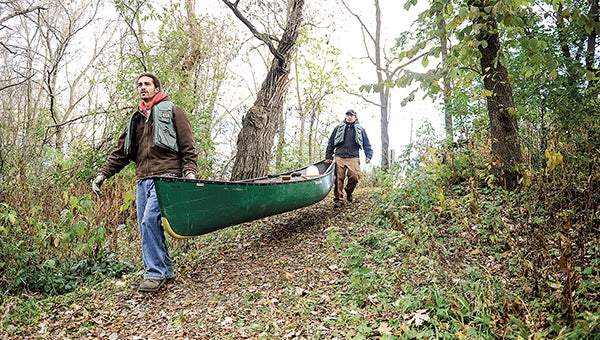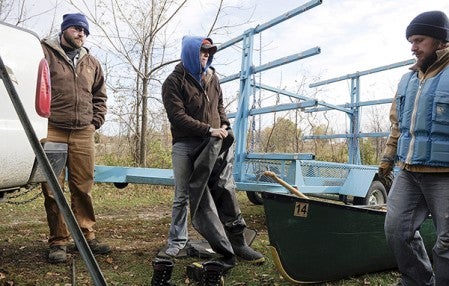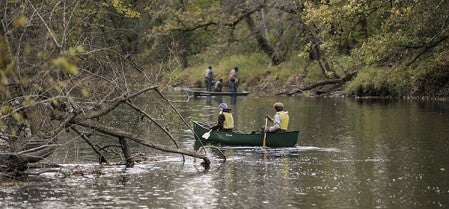A tiresome haul of tires: Volunteers work to clear debris from Cedar
Published 11:20 am Thursday, October 24, 2013

Kris Alvarez, front, and Joe McCarthy carry a canoe to the shore of the Cedar River Wednesday morning. — Eric Johnson
They were dirty, soaked and chilled to the bone after scouring the Cedar River on Wednesday. With fenceposts and muscle, they pried nearly 100 tires from under the muck, and that was only day one.
A group of 15 hardworking volunteers with the Conservation Corps of Minnesota and Iowa returned to the Cedar River south of Austin on Thursday to finish what they started: get as many tires out of the water as possible.

Jennifer LaRoche, with the Conservation Corps, puts waders on before heading to the Cedar River to help clean discarded tires from the river Wednesday.
On Wednesday, the crew — with chest waders, canoes and john boats — stepped into the water near the Solafide Observatory and worked their way about 2.5 miles south. Some tires were small, and near the surface. Others were buried in heavy mud and required back-aching leverage. There were even full-size, rear tractor tires.
Dustin Looman, southern district manager of young adult field crews, and his group have pulled plenty of tires out of other area rivers, too. It’s unfortunate, but the situation is mostly the same across the board, he said. If a good indicator could have come from finding dozens of tires in a river, it was that many of them had been there for a long time. The rate of illegal dumping may not be what it once was.
Several hours after they started, wet and cold on a blustery Wednesday, the group finally stopped. Physically, they could have continued, but they already collected what their boats could handle, and they filled two pickup trucks and a trailer with tires.
“There were a few that they had passed over, just because it was either too deep or there was no more room to put the tires,” Looman said.
The project wouldn’t be possible without coordination among several agencies and state funding. Through support of AmeriCorps and Minnesota’s Clean Water funds, the Conservation Corps tackles these projects with help from 18- to 25-year-olds, who make sacrifices just to do such work.
The workers receive small, monthly living allowances, some college credits and can defer payments on college loans.
For workers like Jon Bunton and Zach Dieterman, it’s a chance to be outdoors, travel and get a foot in the door for careers with the DNR or similar agencies.

Volunteers for the Conservation Corps begin scouring the Cedar River south of Austin Wednesday for tires discarded in the river.
“I’ve always enjoyed doing this outdoors, natural resource work,” said Dieterman, from Lake City.
Dieterman, 25, has done plenty of work with the program since 2011. Among projects in Minnesota and surrounding states, he even helped with last year’s relief efforts after Hurricane Sandy.
Bunton, also 25, has been with the program for four years. He was among nine who recently returned from Alaska, where they assisted on damage cleanup and housing projects.
“It’s been a really good experience,” Bunton said. “I think the greatest thing is that we travel a lot, so we get to meet a lot of different people.”
Wednesday wasn’t the first time the Conservation Corps has helped in the area.
“They’ve been doing some work for Mower County in the last few weeks,” Looman said.
The group assisted with cleanup at a dump site north of Austin, but its local track record goes back further. Justin Hanson, resource specialist with the Cedar River Watershed District, can attest to that.
“We’ve had them every year, probably for the last three or four years,” he said.
Past projects have included tree revetments and sediment reductions on local waterways, and even inventory work. The county receives hard labor hours for little to no cost.
“They’ve just been an outstanding resource,” Hanson added. “Almost always we get a great crew that gets sent down. They work really hard.”
Hanson applies for the state funding that fuels such projects. In many cases, contracting the work would be out of the budget.
“To hire professionals to do a lot of the work they do would cost us a ton of money,” Hanson said.
Removing tires from rivers wouldn’t likely happen on this scale without funding specifically allocated for protecting waters.
“It wouldn’t be possible unless the Clean Water funds were available,” Looman said.
He added, “It just represents a good use of those funds.”
As the saying goes, though, nothing is free. Taxpayers voted for the Clean Water Land and Legacy Act in 2008 at a slightly increased sales tax. Locally, CRWD will have to pay to dispose the tires, but that’s a small cost. To Hanson, it’s still a great trade-off.
“To do a whole cleanup project and all you have to pay is the disposal, I think that’s a pretty good way to spend taxpayer dollars,” he said. “You get all the labor for free. You just have to pay for disposal.”
Conservation Corps groups aren’t done in Mower County, either. Hanson said they will be back for more projects, and as early as next week, when they will remove downed trees and logjams from the Cedar.

